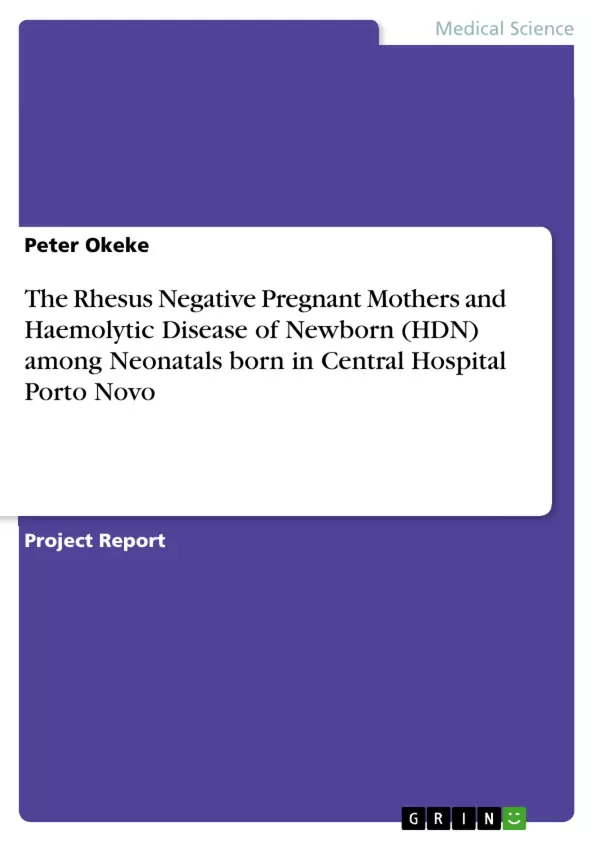A total of 27 blood specimen of neonates born at the maternity section of central Hospital Porto Novo by the Rhesus Negative mothers were studied for a period of 12 months. The specimen collection were done within 72 hours of birth, mothers pregnant for the first time without a past history of abortion or transfusion were rejected for the study. Ten (10) blood specimens of the neonates were Rhesus blood group negative and were eliminated from the work whereas the remaining seventeen (17) were recorded Rhesus blood group positive. The results of the 17 specimen of neonates all recorded in mean values showed Hb 17. 23g/dl, Hct 51.56L/L, the mean cell volume was 102.18 FL, mean cell hemoglobin concentration was 33.41% and mean cell hemoglobin recorded 34.12 pg. The red cell count and white cell count were 5.04 × 10 12/L and 16.06 ×10 9/L respectively. The platelet count was 316.53 and red cell distribution width of 17.76% was recorded. The differential leucocytes counts were; Neutrophils 65.35%, Lymphocytes 25.71% and MXD (comprises of monocytes, eosinophils and basophils) recorded 13.48%. The mean results of Bilirubin direct and Bilirubin total were 0.76mg/dl and 4.29mg/dl. The Direct Coombs test (DCT) was positive in one specimen of neonates and this specimen showed Hb value of 13.6g/dl and a total Bilirubin of 27.5mg/dl. All the neonates were of full term with birth weight of 2.5 to 3.5 kg. This work serves as an epidemiological vigilance for haemolytic diseases of the newborn in the Porto Novo province. The incidence of hemolytic Disease of newborn in Porto Novo district was recorded to be 5.8% considering from this work where only a case gave positive Direct Coombs. Although, this work suffers from scarcity of pregnant mothers of Rhesus blood group negative and affects the research because the specimen collected were small for the time period of the work. The Porto Novo experience also showed that good control system is at work by the medical team and technical staff concerned with the testing of all prospective mothers. Another positive aspect is that anti-D is freely and timely available for mothers of D- positive infants and with persistent effort in this regard, the incidence should continue very low or until there is no more case of hemolytic disease of the newborn.
Inhaltsverzeichnis (Table of Contents)
- Introduction
- ANTENATAL ASSESSMENT OF THE MOTHER'S BLOOD.
- PARTNER TESTING
- Testing Fetal Deoxyribonucleic acid (DNA) in the maternal circulation.
- ANTENATAL ASSESSMENT OF THE SEVERITY OF HDN
- ANTIBODY TITRATIONS DURING PREGNANCY
Zielsetzung und Themenschwerpunkte (Objectives and Key Themes)
The purpose of this work is to investigate the occurrence of hemolytic disease of the newborn (HDN) in the Porto Novo province and provide epidemiological vigilance for this condition. It aims to understand the factors contributing to HDN, particularly the role of Rhesus (Rh) incompatibility between mother and child, and to evaluate the effectiveness of current medical practices in managing the disease.
- Hemolytic disease of the newborn (HDN)
- Rhesus (Rh) incompatibility
- Antenatal assessment of maternal blood
- Partner testing and fetal DNA analysis
- Antenatal assessment of HDN severity
Zusammenfassung der Kapitel (Chapter Summaries)
- Introduction: This chapter defines HDN and explains its causes, particularly Rhesus HDN, which arises from Rh incompatibility between mother and child. The role of IgG antibodies in HDN and the prevalence of Rh HDN in the United Kingdom are discussed.
- ANTENATAL ASSESSMENT OF THE MOTHER'S BLOOD: This section focuses on the importance of routine blood group and antibody testing for pregnant women. It emphasizes the need for regular testing, especially for Rh-negative mothers, and describes various methods for detecting Rh antibodies, including the indirect antiglobulin test (IAT).
- PARTNER TESTING: This chapter discusses the importance of determining the paternal blood group phenotype to assess the risk of HDN. It explains the prediction of zygosity for the D antigen and the advantages of DNA typing for predicting HDN.
- Testing Fetal Deoxyribonucleic acid (DNA) in the maternal circulation: This section explores the advancements in detecting fetal DNA in maternal circulation and using DNA amplification techniques to predict the Rh type of the fetus. This non-invasive method can potentially replace more invasive procedures.
- ANTENATAL ASSESSMENT OF THE SEVERITY OF HDN: This chapter delves into the ongoing development of non-invasive tests for assessing fetal anemia and guiding decisions on intrauterine transfusion in severe HDN cases.
- ANTIBODY TITRATIONS DURING PREGNANCY: This chapter discusses the role of laboratory serology in monitoring antibody levels during pregnancy. It explains the use of different techniques for antibody titration and their importance in predicting the severity of HDN.
Schlüsselwörter (Keywords)
Hemolytic disease of the newborn (HDN), Rhesus (Rh) incompatibility, IgG antibodies, antenatal assessment, partner testing, fetal DNA analysis, antibody titrations, intrauterine transfusion.
- Quote paper
- Peter Okeke (Author), 2010, The Rhesus Negative Pregnant Mothers and Haemolytic Disease of Newborn (HDN) among Neonatals born in Central Hospital Porto Novo , Munich, GRIN Verlag, https://www.grin.com/document/163579



